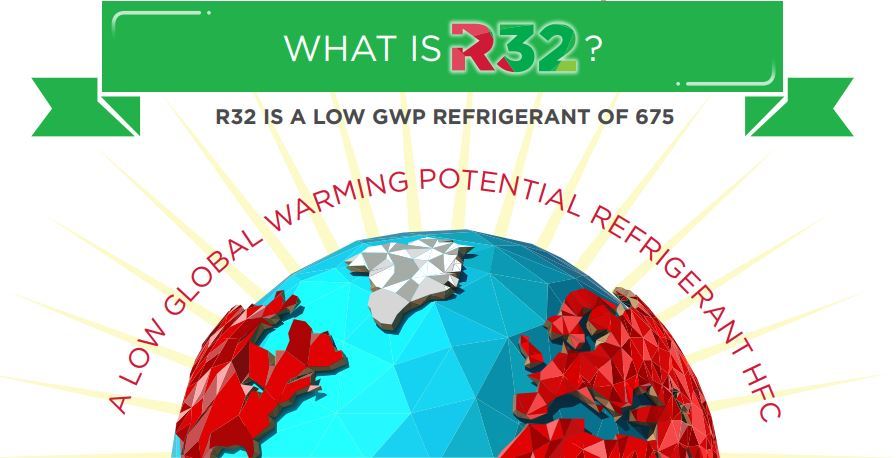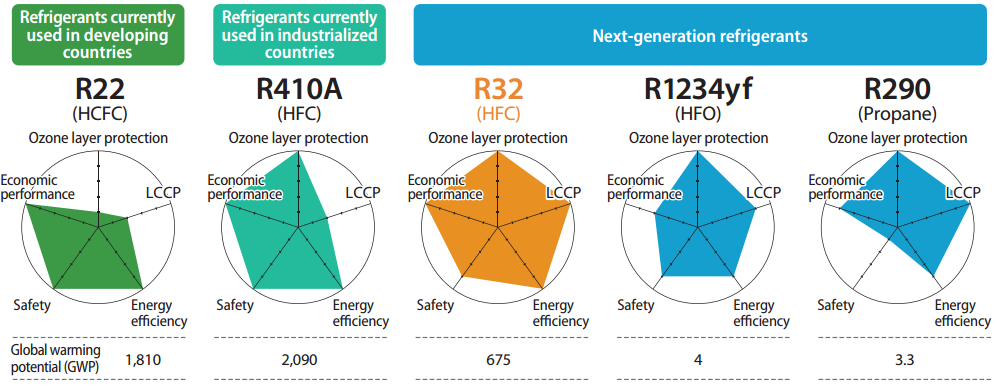
What exactly is the R32 Gas?
R32 is the abbreviation of Difluoromethane, a coolant with zero ozone depletion potential. It is a colorless gas and transparent liquid under room temperature and soluble in oil but hardly soluble in water. The R32 gas is widely used in the air conditioning sector and is said to be the next-generation refrigerant.
When it comes to the creation of R32, one has to review the history of air-conditioning refrigerants and some commonly used refrigerants.
R22, R290, and R410A gas
R22 is a refrigerant that has dominated the air-conditioning industry for decades. Due to its greater harm to the ozone layer, this type of gas has been phased out by most of the countries, according to the Montreal Agreement and the Kyoto Protocol.
Therefore, finding a suitable alternative refrigerant has been an important task for the air-conditioning industry in recent years. As a result, R410A and R290 gas are substitutions for R22 gas that enter the industry.
However, due to the flammable and explosive characteristics, R290 refrigerant is often life-threatening and not suitable for long operations. Despite R410A is not harmful to the ozone layer, but it greatly contributes to global warming.
As the global warming problem continues to worsen, the European Union has taken measures to limit and reduce the production of HFC refrigerants including R410A and R22. Leaders have also announced in reduction of R410A and R290 gas on different occasions.
In short, whether it is R410A or R290, both are not suitable in the long run to become the mainstream of the heat and ventilating market, the R32 refrigerant is the successor of both R410A and R290.

The Global Warming Potential of different refrigerants in the market
The advantages of R32 as refrigerant gas for air conditioners
1. Thermophysical properties:
The refrigerant charge of R32 can be reduced, by 0.71 times that of R410A. The working pressure of the R32 system is slightly higher than that of R410A but it will not exceed 2.6%.
2. Environmental protection characteristics:
ODP value (ozone depletion potential value) is 0, but R32 has moderate GWP value (global warming potential value). Compared with R22, the CO2 emission reduction ratio can reach 77.6%, while R32 is only 2.5%, It is significantly better than R410A in terms of CO2 emission reduction;
3. Safety:
R32 is non-toxic, while R32 is flammable, but among several alternatives to R22, R32, R290, R161, R1234YF, R32 has the highest lower limit of combustion (LFL), and it's the least flammable and is relatively safe compare with its predecessors.
4. Recycling performance:
In terms of theoretical cycle performance, the cooling capacity of the R32 system is 12.6% higher than that of R410A, the power consumption increases by 8.1%, and the overall energy saving is 4.3%. The experimental results also show that the refrigeration system using R32 has a slightly higher energy efficiency ratio than R410A. . Considering that R32 has a greater potential to replace R410A.
Conclusion
As a new generation of energy-saving, carbon-reducing, environmentally friendly, and non-toxic refrigerant, R32 has become an excellent choice.





